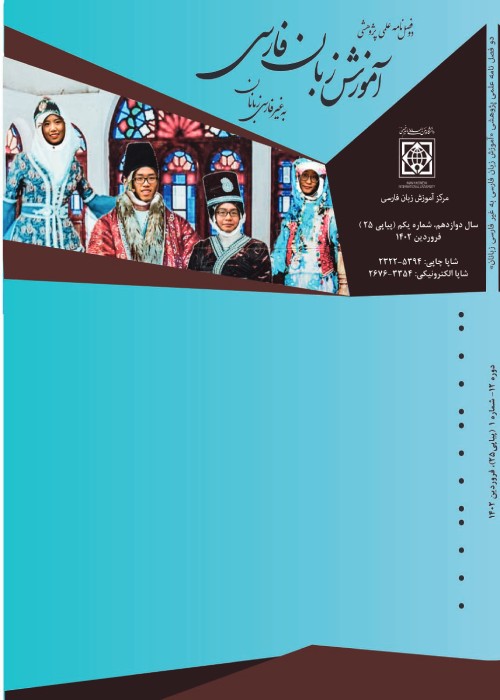Restrictive and Non-Restrictive Relative Clauses in Persian Language: Sequence of Acquisition by Non-Iranian Persian Learners
Learning and teaching must have an effective relation, but of course, there is a gap between these two fields of study. That’s because of two points of view: study of learning and acquisition on the one hand and teaching and curriculum design on the other hand. However, in recent years, much attention has been paid to the nature of second language learning, because understanding the nature of the second language learning will help us to adapt our syllabus and curriculum design in accordance with the learning system and make logical connections between learning and teachings. To this end, this study scrutinized the sequence of acquisition of two types of relative clauses: restrictive and non-restrictive. So, 493 texts from a corpus of Persian learners’ written texts were analyzed. Then, the relative clauses were tagged and according to the level of language learners, they were divided into six categories. After the restrictive and non-restrictive clauses were distinguished, the acquisition of these clauses was examined. The results showed that Persian Learners, regardless of gender, nationality, method of previous teaching and age, learned restrictive relative clauses sooner than non-restrictive ones. Even after learning, they tended to use restrictive clauses more often. The implication of this study is that it is better to teach restrictive clauses sooner to accord with the learners’ sequences of learning. Extended abstract</strong> Learning and education must have an effective relation. Of course, there is a gap between these two fields of study. That’s because of two points of view: study of learning and acquisition on one hand, and teaching and curriculum design, on the other hand. However, in recent years, much attention has been paid to the nature of second language learning/acquisition because understanding the nature of the second language learning will help us to adapt our syllabus and curriculum design in accordance with the learning system. Previous studies (e.g. Fries, 1945; Lado, 1957; James, 1998) during the past decades have shown the importance of first language in acquisition of second language, but the recent studies (e.g. Selinker, 1972; Nemser, 1971; Corder, 1971) indicated that although the role of the first language in learning/acquisition of second/foreign language cannot be ignored, language learners with different first languages, follow the Universal Grammar (UG) and learners’ inter-languages are somehow similar. So, second language learners follow a sequence and order in their acquisition. Thus, in this study, sequence and order of acquisition of two types of relative clauses were scrutinized. Relative clauses can be divided into two types: restrictive and non-restrictive. A restrictive clause is a “clause which functions as an adjective to identify the word it modifies. It is essential for the intended meaning and it is not offset with commas”. On the other hand, “A nonrestrictive modifying clause (or non-essential clause) is an adjective clause that adds extra or nonessential information to a sentence. The meaning of the sentence would not change if the clauses were to be omitted and also they are usually set off by commas”. Knowing that which kind of relative clauses were learned sooner and more accurately by the students could help us to understand how and when Persian language (here relative clauses) is learned. So we can utilize these findings in our teaching, and designing our syllabi and curriculum. The question of this study is “What is the acquisition sequence of Persian relative clauses?’. We supposed that, non-Iranian Persian language learners, learn restrictive relative clauses sooner than non-restrictive clauses and they use this type of relative clause more often than non-restrictive one. The reason behind this hypothesis is that this kind of relative clauses are syntactically easier because there is no movement or extra structure on their derivation. In order to test this hypothesis, 493 Persian learner’s written texts were analyzed. The learners were from various countries such as Austria, Argentina, Spain, Australia, Afghanistan, Slovakia, Slovenia, Algeria, the United Kingdom, Ukraine, Italy, Azerbaijan, Argentina, Germany, USA, Belarus, Belgium, Bulgaria, Bangladesh, Bosnia, Pakistan, Portugal, Tajikistan, Taiwan, Turkey, Tunisia, Czech, China, Russia, Romania, Syria, Switzerland, Serbia, Iraq, France, Kyrgyzstan, Croatia, Colombia, Georgia, Lebanon, Poland, Hungary, Egypt and India. Therefore, the first language of learners is not influential factor in this study. The data were collected from two exams (placement test and progress test which is conducted by Sa’di Foundation in 2015 & 2016) and the learners had to use at least 120 words in their writings. After that, the data were gathered and tagged as a restrictive relative clauses and non-restrictive relative clauses. According to the level of language learners, they were divided into six groups; beginner, elementary, low intermediate, intermediate, upper intermediate, advanced, and proficient. The results showed that regardless of gender, nationality, method of previous teaching and age, in general, the higher level students use restrictive relative clauses in their language more accurately. And the emergence of non-restrictive relative clause occurs later and less than the other type even in advanced and proficient levels. Thus, we can conclude that the Persian language learners will learn restrictive relative clauses sooner than non-restrictive ones. The interesting point of this study is that even after learning non-restrictive relative clauses, the Persian language learners tend to use restrictive clauses more often. Perhaps this happens because of the economy principle (the least effort) of language which was introduced for the first time by Zipf (1949). The aim of this principle is the maximum effect with the least input. So, as non-restrictive relative clauses have extra information, language learners prefer not to use it as long as they can. On the other hand, they tend to use restrictive relative clause because of the meaning that it determines. Since one of the most important issues in second/foreign language learning/acquisition is native-like competence, we can conclude that it is better to teach restrictive clauses before non-restrictive relative clauses to incorporate education and sequences of learning/acquisition for effective teaching and learning.
- حق عضویت دریافتی صرف حمایت از نشریات عضو و نگهداری، تکمیل و توسعه مگیران میشود.
- پرداخت حق اشتراک و دانلود مقالات اجازه بازنشر آن در سایر رسانههای چاپی و دیجیتال را به کاربر نمیدهد.



